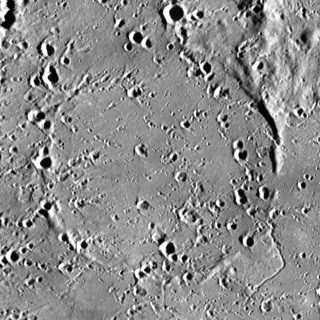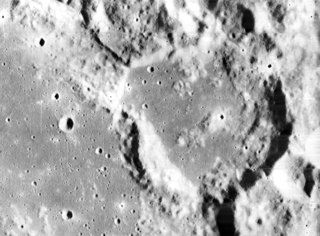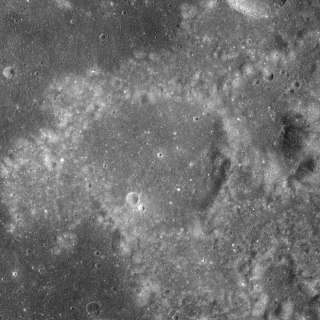
Zupus is the lava-flooded remains of a lunar impact crater. It is located on a southwestern reach of the Oceanus Procellarum, to the northwest of Mare Humorum. To the north-northeast is the flooded crater Billy, and some distance to the southeast is Mersenius. A system of faint rilles named the Rimae Zupus lie to the northwest, following a course to the north-northwest towards the mare.

Stadius is a ghostly remnant of an ancient lunar impact crater that has been nearly obliterated by basaltic lava flows. It was named after Flemish astronomer Johannes Stadius. It lies to the southwest of the much younger crater Eratosthenes, at the north edge of Mare Insularum where the mare joins Sinus Aestuum. To the west is the prominent ray crater Copernicus, and multiple secondary craters from the Copernican ejecta cover this area. To the northwest is a chain of craters that continue in a roughly linear formation until reaching Mare Imbrium.

Bruce is a small lunar impact crater located in the Sinus Medii. It lies to the west-northwest of the irregular crater Rhaeticus, and is about 33 km to the west of the even smaller Blagg. It is named for Catherine Wolfe Bruce, an American philanthropist and patroness of astronomy.

Chladni is a small lunar impact crater that lies near the northwest edge of Sinus Medii, in the central part of the Moon. The crater is named for German physicist and musician Ernst Chladni who, in 1794, wrote the first book on meteorites. The rim of the crater is roughly circular, and there is a small central floor at the midpoint of the sloping inner walls. This feature has a higher albedo than the surrounding terrain. It is connected by a low ridge to the rim of the crater Murchison, which lies to the northwest. Due east of Chladni is the larger Triesnecker.

Flammarion is a lunar impact crater on the south edge of Sinus Medii. Its diameter is 76 km. It is named after the French astronomer Camille Flammarion. It is located between the crater Mösting to the northwest and Herschel to the southeast. The bowl-shaped Mösting A intersects the western rim of Flammarion.

Appleton is a heavily eroded lunar impact crater that lies in the northern hemisphere on the far side of the Moon. To the northwest are the craters Von Neumann and Campbel. The smaller Golovin lies to the northeast, while further to the southwest is the Mare Moscoviense.

Archytas is a lunar impact crater that protrudes into the northern edge of Mare Frigoris. To the northwest is the comparably sized crater Timaeus, and the smaller Protagoras lies in the opposite direction to the southeast. Further to the southwest, beyond the opposite edge of the mare, is the dark-floored crater Plato.

Brenner is an old lunar impact crater that lies in the rugged southeastern part of the Moon's near side. It is named after the Serbian-Austrian astronomer Spiridon Gopčević. It is located within one crater diameter northwest of the crater pair Metius and Fabricius.

Blanchard is a lunar impact crater that lies on the far side of the Moon, just behind the southwestern limb. It lies to the south-southwest of the crater Arrhenius, and northwest of Pilâtre. Further to the south is the rugged terrain to the north of the walled plain Hausen.

Lyell is a lunar impact crater that lies along the eastern edge of the Mare Tranquillitatis, at the northern arm of the bay designated Sinus Concordiae. It was named after Scottish geologist Charles Lyell. To the north along the edge of the lunar mare is the crater Franz. The region of terrain to the east of Lyell is named Palus Somni.

Cuvier is a lunar impact crater on the southern part of the Moon's near side. It is attached to the east-southeast rim of the unusually shaped formation Heraclitus. To the northeast is the crater Clairaut.

Cannon is a lunar impact crater that is located near the east-northeastern limb of the Moon's near side. It lies just to the northwest of the Mare Marginis, and south-southeast of the crater Plutarch. Farther to the east-northeast is Hubble.

Cayley is a small lunar impact crater that is located in a lava-flooded region to the west of Mare Tranquillitatis. It was named after the 19th century British mathematician Arthur Cayley. It lies to the northwest of the smaller crater De Morgan and the larger D'Arrest. West and slightly north of Cayley is Whewell, a crater of about the same dimensions. To the north is a linear rille designated Rima Ariadaeus, which follows a course to the east-southeast.

Condon is a lunar impact crater that lies on the eastern shore of the Sinus Successus, a bay along the northeast edge of Mare Fecunditatis. It was named after American physicist Edward U. Condon. It lies midway between the larger crater Apollonius to the north and the smaller Webb to the south on the Mare Fecunditatis. Condon was previously designated Webb R.

da Vinci is a lunar impact crater that is located in the eastern part of the Moon, to the northwest of Mare Fecunditatis. It lies along the eastern shore of the Sinus Concordiae, a bay along the eastern edge of Mare Tranquillitatis. Nearby craters include Watts to the southeast and Lawrence to the southwest, both smaller in dimension than da Vinci.

South is a large lunar impact crater that is located in the northwest part of the Moon. Most of the southern wall of this crater is joined to the Sinus Roris bay of the Oceanus Procellarum, with the southeast rim facing Mare Frigoris. Attached to the northwest of the formation is the larger walled plain Babbage. Just to the northeast is the crater Robinson, and farther to the northeast is another walled plain, J. Herschel.

Drude is a lunar impact crater that lies on the far side of the Moon, in the rugged Montes Cordillera range that forms the outer ring around the Mare Orientale impact basin. It is located just behind the west-southwest limb, and this area is sometimes brought into sight from Earth during favorable librations. However, even at such times, the crater is viewed from the edge and little detail can be seen.

Yangel' is a small lunar impact crater that is located in the irregular terrain to the north of the Mare Vaporum. Its diameter is 8 km. It was named after Soviet rocketry scientist Mikhail Kuzmich Yangel' in 1973. This crater was formerly designated Manilius F.

Esclangon is a lunar impact crater that is located in the rugged terrain to the northwest of the prominent crater Macrobius, and east of Sinus Amoris. Its diameter is 15 km. It was named after French astronomer Ernest Esclangon. This formation was previously designated Macrobius L. Just to the west-southwest is the crater Hill. Lacus Bonitatis, the Lake of Good, is located to the east and northeast of Esclangon.

File: Franz is a small lunar impact crater identified during the Apollo mission in August 1971 and located along the eastern edge of the Sinus Amoris, a bay that forms a northern extension to the Mare Tranquillitatis. Its diameter is 25 km. It was named after German astronomer Julius Heinrich Franz. It lies to the southwest of the prominent crater Macrobius. To the north is the smaller Carmichael, and to the northwest is the diminutive Theophrastus.



























